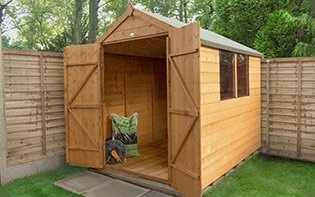Wooden Garden Sheds Advice
Reading time: 5 minutes
Which garden shed?
Let’s break down the different things to look at in order to make an informed choice. It’s worth pointing out that while cost is usually a consideration, it might not always be the most important thing when finding the right type of shed.
What will you use a shed for?
The first stage in choosing your new garden shed is to decipher what it will be used for. Do you need somewhere to store your bikes and scooters, lawn mowers and strimmers, garden or work tools or all of the above? This may sound like a silly question, but once you know what you plan to store in your shed, you should have a pretty good idea as to the size you need.
Where will you place your shed?
Deciding where you’re going to put your new shed will determine what kind of base you’ll need, depending on the type of ground surface you’ll be placing it. This will also confirm if the size of shed you have in mind will fit in to your chosen space!
Will you need planning permission for a garden shed?
Depending on shed size and placement planning permission may be needed. While planning permission for a shed is not usually necessary (as most people site their shed within 2m of a boundary), there is a 2.5m restriction on maximum shed height, this is rarely a problem as few sheds are taller than this. It’s always advisable to check your local council to be sure that your plans fall within the restrictions.
Shed bases
Installing your outdoor storage on to a stable foundation is an important consideration, this will ensure the structure is sturdy and sound. Whilst most timber sheds will come supplied with a base, this might not always be the case, or you may want to lay your own.
The critical elements of a shed base are that it is flat and stable, won’t sink or allow weeds to grow through, and won’t encourage standing water. If the base is not perfectly level then the shed will not stay straight and true, posing potential problems with doors and windows.
Concrete shed bases
It’s said that the best shed bases are made from a poured concrete pad or concrete slabs, although gravel laid on a suitable hard-core base is also sometimes used. A solidly constructed base will have it’s obvious benefits of being rigid, less likely to sink and no weed growth, but could be laborious, messy and time consuming.
Timber shed bases
Usually supplied with a wooden shed, these are quick and easy to assemble and some kits include spikes fixed to the base which are used to help level the base on uneven ground. It should be noted that if a timber shed base is built onto unprepared ground, weeds will grow up under the shed, so a suitable weed membrane or suppressant should be used.
Good quality sheds come with pressure treated floor bearers that can be placed directly onto the base and isolate the floor and walls from ground contact.
Eco shed bases
With the environment firmly on our minds these days, eco bases are becoming more and more popular. They’re often available in kit form boasting an ‘easy fit’ using an interlocking system that’s a real timesaver. They’re usually made of recycled plastic with a permeable honeycomb-effect grid construction, which is robust, waterproof and rot-resistant.
Shed construction - does it make a difference?
Overlap sheds feature horizontal boards overlapping the next to ensure water runs down to the ground. This type of shed is an economical choice and is suitable to store garden equipment and tools, or used as a potting shed. The overlapping boards have a rustic appearance and are free to move between the internal framing battens. This means that gaps will open and close as temperatures vary. This is entirely normal and helps keep the shed well ventilated.
As with most things, the more you pay the better the quality, so if you have a bigger budget you could choose the tongue & groove or shiplap tongue & groove cladding. Both feature interlocking boards that are less prone to gapping when it is hot and dry - making them suitable for storing more expensive outdoor equipment, such as bicycles and lawnmowers. The cladding is also thicker than overlap sheds, so they are more robust, longer lasting and secure. Shiplap cladding has a traditional finish while tongue & groove is more contemporary.
Types of shed roofing
Most sheds will have an apex or pent roof design. These are suited to different uses and have a different aesthetic. Apex sheds have a traditional look and work well in an open area, while pent sheds are of a contemporary style and well suited to being placed against fences and walls.
Apex roofs
Apex roofs feature two sloping sections, meeting in the middle to form a ridge. This design allows you to maintain an access ‘corridor’ down the middle of the shed whilst using the sides and back wall for storage, shelving or work benches.
Pent roofs
Pent roofs have a single inclined roof section which slopes from the front to the back, giving more head room at the front of the shed across its full width. This makes them suited to storing equipment at the back of the shed and using the front for gaining access or placing a workbench.
Disclaimer: The information contained on this page is intended as an overall introduction and is not intended as specific advice from a qualified professional. Travis Perkins aims to avoid, but accepts no liability, in the case that any information stated is out of date.
Always refer to the manufacturer's guidance for installation instructions and product maintenance.







